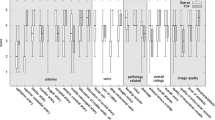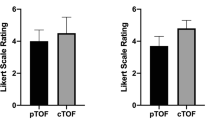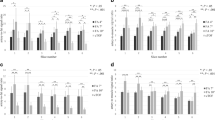Abstract
Object
The purpose of this study was to optimize and to evaluate 3D time-of-flight (TOF)-like non-contrast enhanced MR-angiography (MRA) techniques for display of the intracranial vessels on a 7 T whole-body scanner.
Materials and methods
Three different gradient echo sequences (TOF, VIBE, MPRAGE) were compared in 12 healthy volunteers and 13 patients. Two blinded senior radiologists independently rated the presence or absence of artefacts and the conspicuity of ten different vessel segments in source and maximum-intensity-projection (MIP) images.
Results
In source images, MPRAGE achieved the best results; even the fine vessels and the vessels near the air-containing mastoid were depicted very well. Intraluminal signal loss, which was a problem in the greater vessels in TOF and VIBE imaging, was less pronounced in MPRAGE images. In the MIP images, TOF performed best. Both VIBE and MPRAGE can generate TOF-like contrast and cover the whole brain in less than 15 min, whereas TOF covered only a subvolume of the brain.
Conclusion
MPRAGE performed especially well in this 7 T imaging study. The accuracy of the sequence deserves further evaluation in patients with vessel stenoses and aneurysms.
Similar content being viewed by others
References
Willinek WA, Born M, Simon B, Tschampa HJ, Krautmacher C, Gieseke J, Urbach H, Textor HJ and Schild HH (2003). Time-of-flight MR angiography: comparison of 3.0-T imaging and 1.5-T imaging-initial experience. Radiology 229: 913–920
Al-Kwifi O, Emery DJ and Wilman AH (2002). Vessel contrast at three Tesla in time-of-flight magnetic resonance angiography of the intracranial and carotid arteries. Magn Reson Imaging 20: 181–187
Gibbs GF, Huston J 3rd, Bernstein MA, Riederer SJ and Brown RD (2004). Improved image quality of intracranial aneurysms: 3.0-T versus 1.5-T time-of-flight MR angiography. AJNR Am J Neuroradiol 25: 84–87
Liang L, Korogi Y, Sugahara T, Onomichi M, Shigematsu Y, Yang D, Kitajima M, Hiai Y and Takahashi M (2001). Evaluation of the intracranial dural sinuses with a 3D contrast-enhanced MP-RAGE sequence: prospective comparison with 2D-TOF MR venography and digital subtraction angiography. AJNR Am J Neuroradiol 22: 481–492
Liang L, Korogi Y, Sugahara T, Ikushima I, Shigematsu Y, Takahashi M and Provenzale JM (2002). Normal structures in the intracranial dural sinuses: delineation with 3D contrast-enhanced magnetization prepared rapid acquisition gradient-echo imaging sequence. AJNR Am J Neuroradiol 23: 1739–1746
Maderwald S, Theysohn JM, Kraff O, Ladd SC, Ladd ME, Wicklow K, Quick HH, Gizewski ER (2007) To TOF or not to TOF; Nonenhanced MRA at 7 T. In: Proc intl soc mag reson med, vol 15. ISMRM; Berlin, p 2290
Rofsky NM, Lee VS, Laub G, Pollack MA, Krinsky GA, Thomasson D, Ambrosino MM and Weinreb JC (1999). Abdominal MR imaging with a volumetric interpolated breath-hold examination. Radiology 212: 876–884
Wetzel SG, Cha S, Law M, Johnson G, Golfinos J, Lee P and Nelson PK (2002). Preoperative assessment of intracranial tumors with perfusion MR and a volumetric interpolated examination: a comparative study with DSA. AJNR Am J Neuroradiol 23: 1767–1774
Wetzel SG, Law M, Lee VS, Cha S, Johnson G and Nelson K (2003). Imaging of the intracranial venous system with a contrast-enhanced volumetric interpolated examination. Eur Radiol 13: 1010–1018
Lin C, Bernstein MA, Gibbs GF and Huston J 3rd (2003). Reduction of RF power for magnetization transfer with optimized application of RF pulses in k-space. Magn Reson Med 50: 114–121
Griswold MA, Jakob PM, Heidemann RM, Nittka M, Jellus V, Wang J, Kiefer B and Haase A (2002). Generalized autocalibrating partially parallel acquisitions (GRAPPA). Magn Reson Med 47: 1202–1210
White PM, Wardlaw JM and Easton V (2000). Can noninvasive imaging accurately depict intracranial aneurysms? A systematic review. Radiology 217: 361–370
Dagirmanjian A, Ross JS, Obuchowski N, Lewin JS, Tkach JA, Ruggieri PM and Masaryk TJ (1995). High resolution, magnetization transfer saturation, variable flip angle, time-of-flight MRA in the detection of intracranial vascular stenoses. J Comput Assist Tomogr 19: 700–706
Wiesinger F, Vande Moortele PF, Adriany G, De Zanche N, Ugurbil K and Pruessmann KP (2004). Parallel imaging performance as a function of field strength–an experimental investigation using electrodynamic scaling. Magn Reson Med 52: 953–964
Wiggins GC, Triantafyllou C, Potthast A, Reykowski A, Nittka M and Wald LL (2006). 32-Channel 3 Tesla receive-only phased-array head coil with soccer-ball element geometry. Magn Reson Med 56: 216–223
Collins CM, Liu W, Schreiber W, Yang QX and Smith MB (2005). Central brightening due to constructive interference with, without, and despite dielectric resonance. J Magn Reson Imaging 21: 192–196
Author information
Authors and Affiliations
Corresponding author
Additional information
For inclusion of the special issue on High Field MR as new concepts paper.
Rights and permissions
About this article
Cite this article
Maderwald, S., Ladd, S.C., Gizewski, E.R. et al. To TOF or not to TOF: strategies for non-contrast-enhanced intracranial MRA at 7 T. Magn Reson Mater Phy 21, 159 (2008). https://doi.org/10.1007/s10334-007-0096-9
Received:
Revised:
Accepted:
Published:
DOI: https://doi.org/10.1007/s10334-007-0096-9




